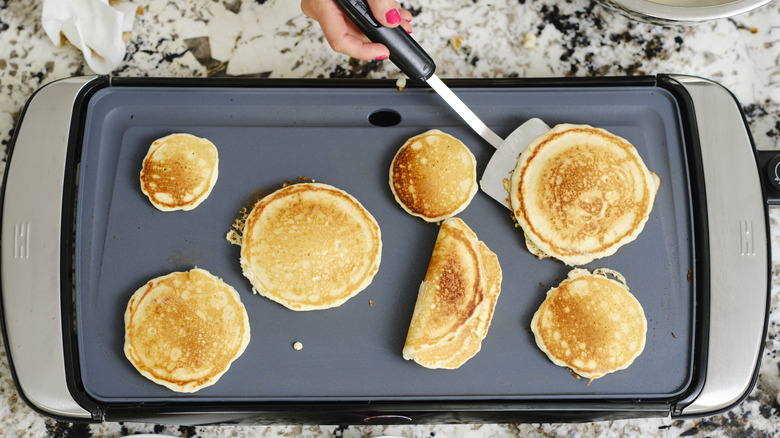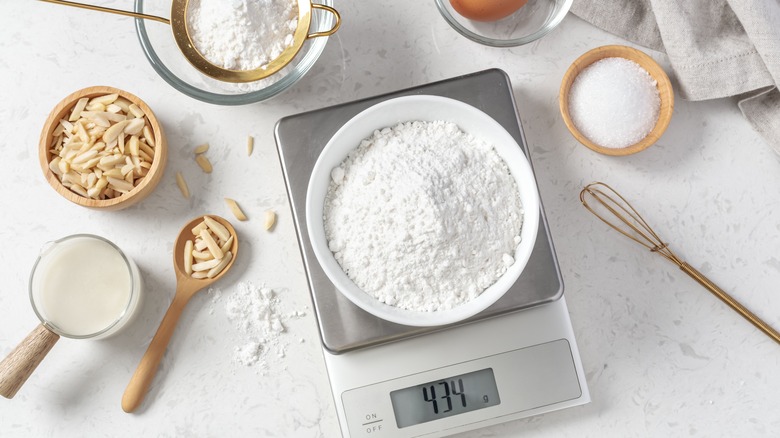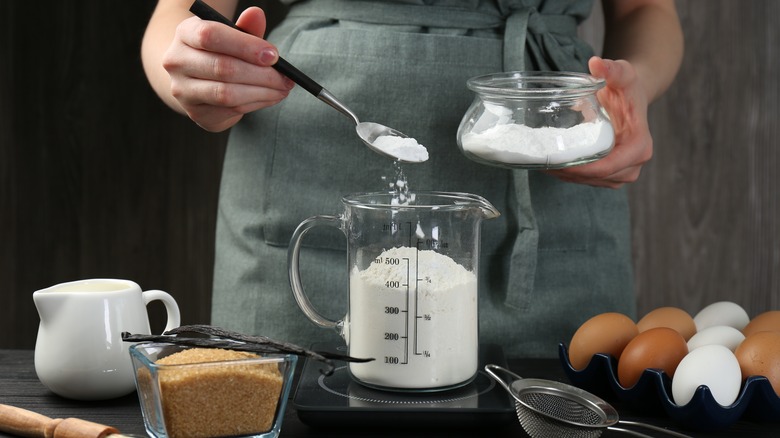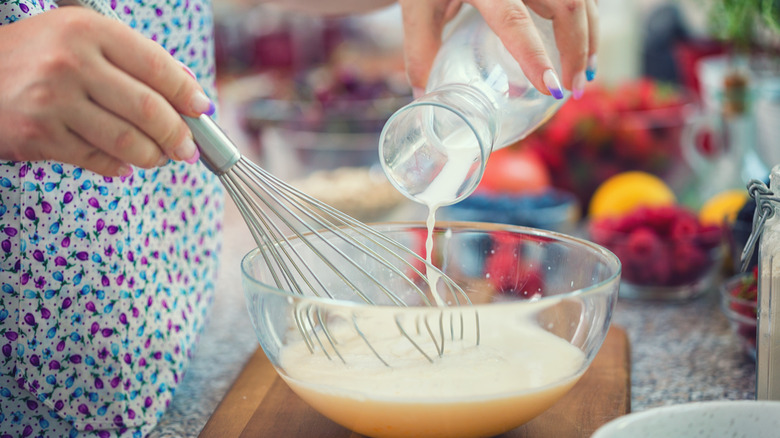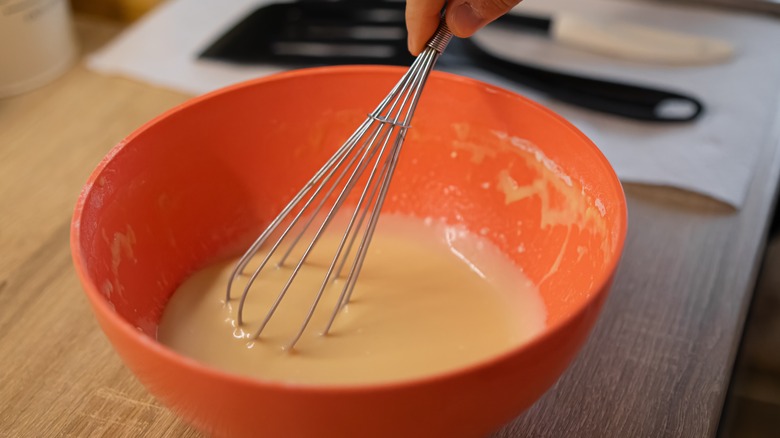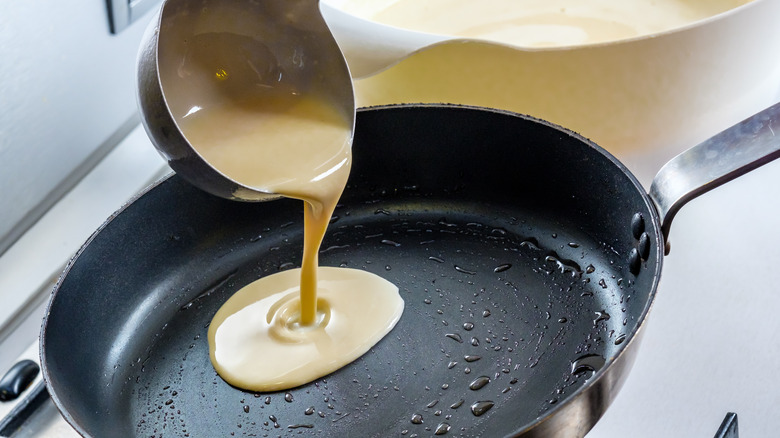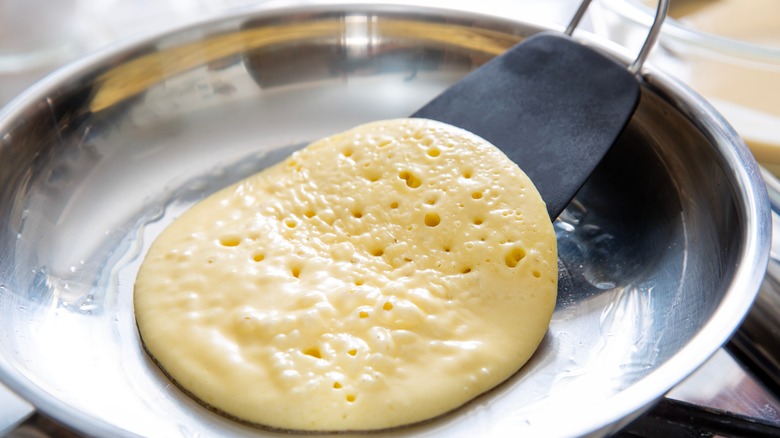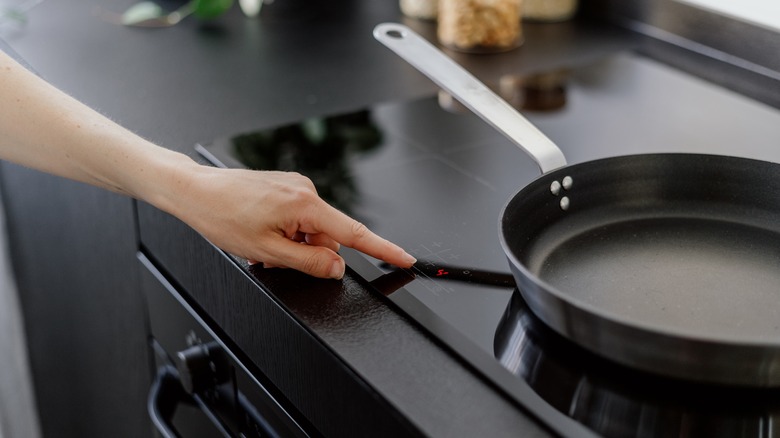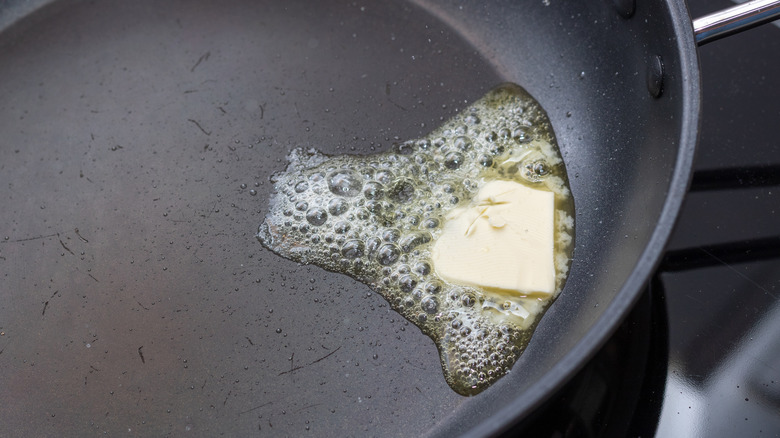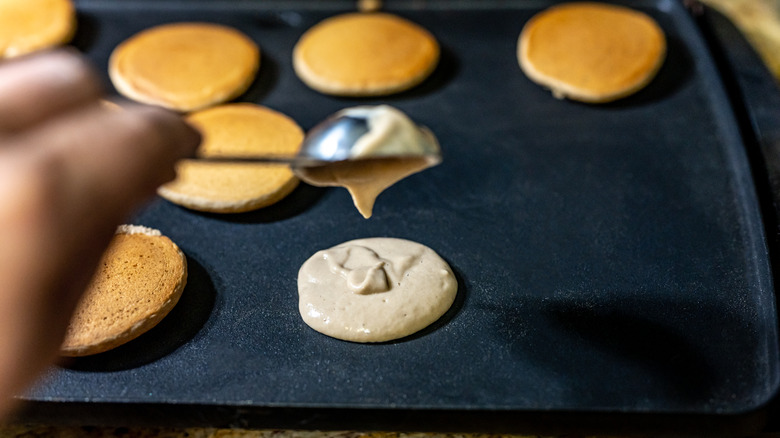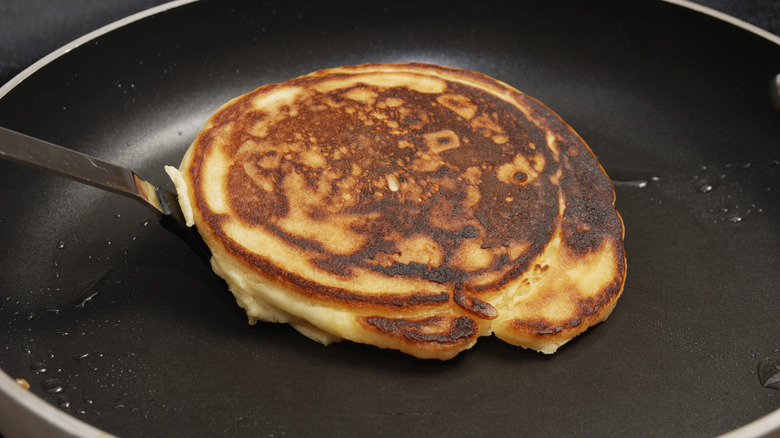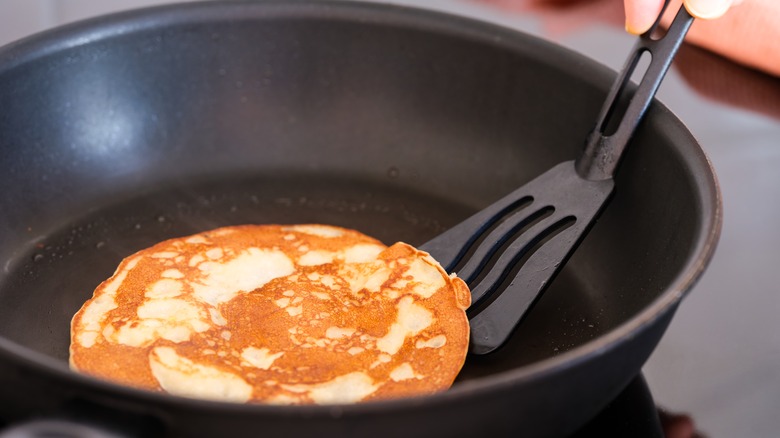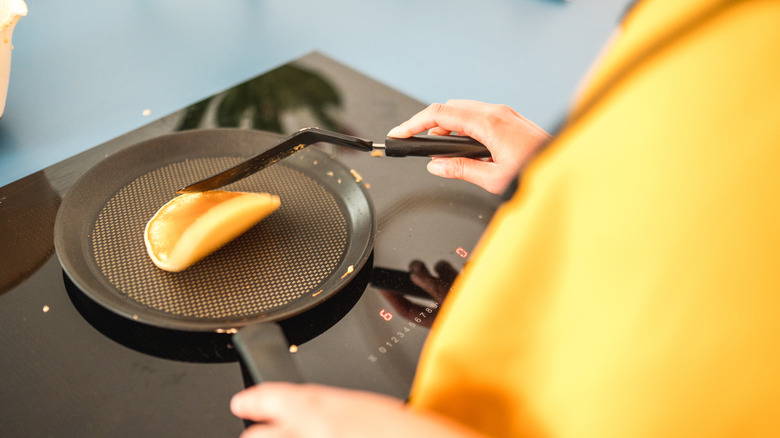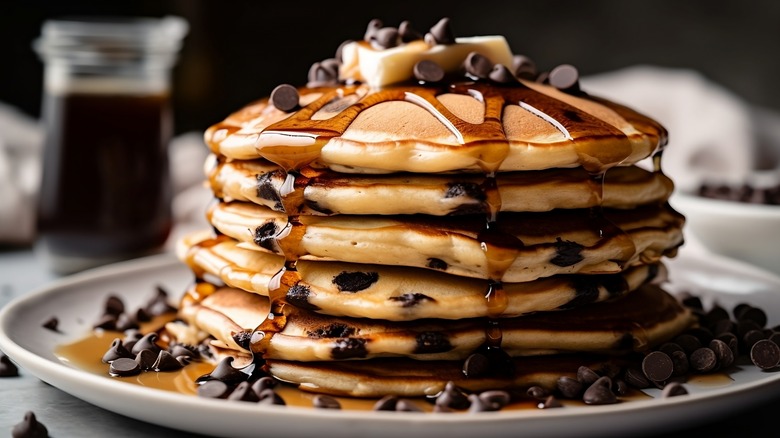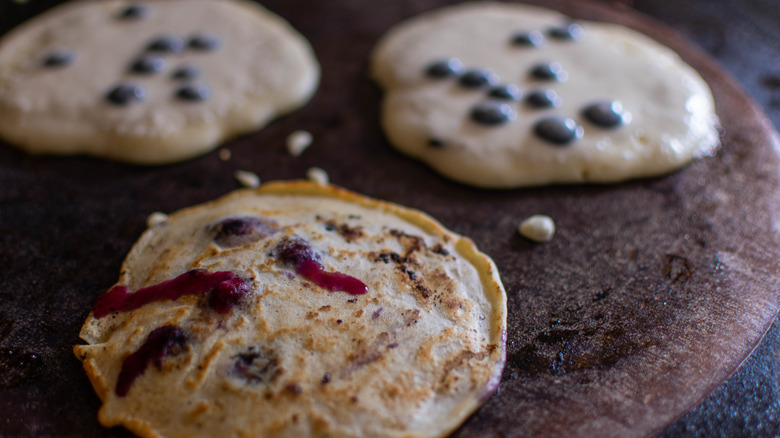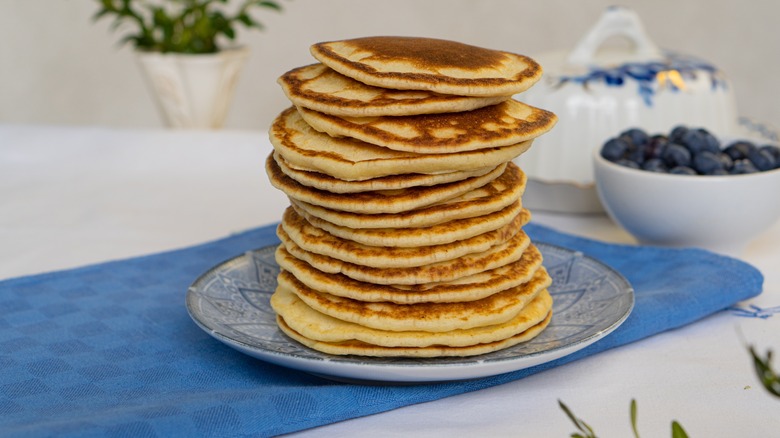15 Common Mistakes You're Probably Making With Pancakes, According To Experts
We may receive a commission on purchases made from links.
Whether you make pancakes weekly or only heat up your griddle on special occasions, you want the finished product to be light, airy, and utterly delicious. If you've been disappointed that pancakes from a restaurant always seem to taste better than your own, it doesn't always have to be that way. You could simply be making one or more of the many mistakes that stand in the way of preparing perfect pancakes.
To learn more about these potentially pancake-destroying mistakes and how to avoid them, we consulted with three baking experts. Jessie-Sierra Ross is a cookbook author of Seasons Around the Table, a food & lifestyle blogger at Straight to the Hips, Baby, and a TV food content creator at NBC, CBS, PBS; Corrie Duffy is a chef and food blogger at Corrie Cooks; and Jessie Sheehan is a podcast host and cookbook author of Snackable Bakes: 100 Easy-Peasy Recipes for Exceptionally Scrumptious Sweets and Treats and the forthcoming Salty, Cheesy, Herby, Crispy Snackable Bakes: 100 Easy-Peasy, Savory Recipes for 24/7 Deliciousness. Keep reading to learn how to prepare utterly delicious pancakes — you may even find that you have some leftover pancake mix that you can put to several other good uses.
Not measuring the ingredients
Eyeballing ingredients instead of measuring them is one of the biggest mistakes people make when reading a recipe. It is also a sure fire way to mess up your pancakes. Adding a little too much — or not enough — of one or more of the ingredients could impact the taste and/or texture of the finished pancakes. "For instance, if you use too much flour, your pancakes will be dense and dry. If you use too much of your liquid ingredient, the batter will be too wet and your pancakes will spread," explains Jessie Sheehan.
Sheehan further recommends using a scale, not a measuring cup, to measure the flour for a pancake recipe. If the flour is more tightly packed in the measuring cup, you may add too much to the batter. When you use a scale, you take the guesswork out of the equation and can feel confident that you are adding the correct amount. Remember, 1 cup of flour weighs about 125 grams (4.5 ounces).
Using expired baking powder or baking soda
Understanding expiration dates on food is important. In many cases, items can be used past these expiration dates. However, while expired baking powder and baking soda aren't likely to make you sick, adding them to your pancake batter will be a mistake. Corrie Duffy explains that expired leavening agents "won't work properly, resulting in flat pancakes."
To avoid flat and boring pancakes, replace your baking soda and baking powder before their expiration date has passed. If you're unsure whether the agents in your pantry are expired, Duffy says you can perform a "test by adding a bit to vinegar or water to see if it bubbles." You don't have to throw out the old packages of baking soda and baking powder, however. They can be saved to use for cleaning tasks around the home. Baking soda will be the most effective because of its chemical makeup and abrasive nature, so save it for your heavier duty cleaning needs.
Not properly mixing the batter
Properly mixing pancake batter is essential if you want the finished product to turn out light and fluffy. Undermixing and overmixing can cause problems, so you'll need to strike that perfect balance. "Lumpy batter causes uneven cooking and unpleasant textures," shares Corrie Duffy. Instead, Duffy recommends using a whisk and stirring gently to get rid of lumps, further explaining, "smooth batter ensures even cooking and fluffy pancakes."
Overmixing is one of the most common mistakes people make when baking a cake, and it can be just as detrimental when preparing pancakes. Jessie-Sierra Ross explains, "Just like a traditional cake batter, a pancake batter can become over-mixed quickly. Over mixing will deflate those helpful air bubbles that make your pancakes super light and fluffy." You don't need to beat the batter. Ross reminds everyone, "We are just incorporating our wet and dry ingredients. A few little pockets of flour are alright!"
Skipping the rest time for the batter
When you make pancakes, do you immediately start cooking them after you've finished mixing the batter? If so, you've been making a mistake. Pancake batter should be allowed to rest before it is dolloped onto the griddle. According to Corrie Duffy, if you skip this important rest time, the pancakes you prepare will end up too tough.
Duffy explains, "Resting allows the flour to absorb the liquid and the gluten to relax." When the flour is given this opportunity the resulting pancakes will be much more tender and fluffier than they would have otherwise turned out. Don't worry, you don't need to leave too much extra time for the batter to rest. According to Duffy, letting the batter sit for about 10 minutes before you start cooking the pancakes should be enough time to leave you with a tender and fluffy finished product.
Not using a ladle to ensure evenly-sized pancakes
Would you be happy if the person sitting across from you at a restaurant received two large pancakes while you were served tiny little discs? Probably not. The same is true when you're preparing and serving pancakes at home. Whether you're cooking for a crowd or just making a few pancakes for yourself and a partner on a lazy weekend morning, you want each pancake to be evenly-sized.
Beyond the obvious difference in looks, Corrie Duffy explains that pancakes of different sizes don't cook evenly. When the smaller ones are ready to remove from the skillet or griddle, the larger pancakes may still be wet in the middle. Duffy says, "Use a scoop or ladle to ensure your pancakes are the same size and cook at the same rate. Consistent sizes make for evenly cooked and appealing pancakes."
Using the wrong sort of pan
Don't make the mistake of choosing a pan that will sabotage your perfect pancakes. According to Jessie-Sierra Ross, "A large nonstick skillet or well greased cast iron skillet is great for making golden and fluffy pancakes." There are a few reasons that these are among the best cookware options when preparing pancakes.
Ross says, "We want a pan that can retain and maintain an even temperature." Both cast iron and nonstick can accomplish this goal. With nonstick pans, the coating can also help prevent your cakes from sticking or burning as they cook. If you're going to choose a nonstick pan, opt for a thicker and heavier one over a lighter one. Thick pans will heat more evenly and retain heat better than thinner ones. offers some additional benefits: In addition to heat retention, the cooking surface on cast iron can help ensure the pancakes are beautifully browned and end up with an appealing texture.
Failing to preheat the griddle or skillet
Once you've selected the ideal pan for cooking your pancakes, you can't simply scoop the batter in right away. While you should cook bacon in a cold pan, the opposite is true for pancakes. Jessie Sheehan says, "If you don't preheat your griddle or skillet, your pancakes will not cook properly and will likely not keep their shape." She explains that the pancake batter will spread too much if the griddle isn't preheated, while "a hot griddle/skillet helps set the bottom of the pancake when you initially pour in the batter."
Preheating is essential, but you also want to avoid overheating the pan. "Cooking pancakes on too high heat can cause them to burn outside and remain raw inside," says Corrie Duffy. To prevent this from happening, Duffy recommends cooking pancakes over medium heat. "Test with a drop of batter that should sizzle gently," suggests Duffy.
Not properly greasing the pan
Even if you're looking to make healthier pancakes, you can't skip the step of greasing the pan. "Cooking pancakes without adding fat can make them stick and burn," says Corrie Duffy. Pancakes that are burnt or stuck in the pan will surely put a damper on your meal. Instead, follow Duffy's advice and add some butter or oil to ensure that "the pancakes cook evenly and get a nice golden color."
According to Jessie-Sierra Ross, knowing how much fat to add to the pan is equally important. If you don't add enough butter or oil, your pancake will likely burn and develop a tougher texture. Conversely, too much fat can prevent the pancakes from cooking evenly, leaving some overly crisp on the outside while others aren't fully cooked on the inside. "I like to use about 1 tablespoon of butter, completely melted and spread across the pan, for every 6 or so medium pancakes," says Ross.
Cramming too many pancakes onto the griddle
If you're making a huge batch of pancakes, it can be tempting to squeeze as many as you can onto the griddle so you finish cooking more quickly. However, this is not a wise choice. Jessie Sheehan explains, "They may run into each other [leaving you with] one massive, strangely shaped pancake, as opposed to several small, adorably circular ones.
Unfortunately, there isn't a simple answer for how many pancakes you can cook at the same time. It will depend on the size of the pan or griddle you're using, the size of the scoop, and the consistency of the batter and how much it spreads. "To determine how many pancakes will fit on your griddle/skillet at a time, start with one, and see how much it spreads." Once the first pancake has finished spreading you'll be able to see how much space you have to plop in another batter dollop so they don't run into each other.
Flipping too soon or too late
Flipping your pancakes at the right time is essential if you want them to turn out properly. Corrie Duffy explains, "Flipping pancakes too early can cause them to break." Both Duffy and Jessie Sheehan recommend waiting until you see bubbles on the top side of the pancakes before flipping them. Sheehan says, "If you do not wait for bubbles, you risk the chance that the other side of the pancake is not yet ready to be flipped."
While it isn't good to flip your pancakes too early, it is just as bad to wait too long before flipping them. If you let the pancake cook too long on one side, Duffy explains that it could end up getting burnt. While the cooking time for a pancake will vary some, as a general rule, they typically need to cook for about 2 minutes on the first side and for an additional minute or so after being flipped.
Flipping more than one time
If you end up flipping your pancakes a bit too early, you may think you can easily fix the problem by flipping them back over and letting the other side cook for a bit longer. However, it doesn't quite work like this. Jessie Sheehan says, "It is a good idea to only flip your pancakes only once otherwise you risk creating pancakes that are tough."
Mastering the art of perfectly-cooked pancakes with just one flip may take some practice. Sheehan highlights the importance, once again, of waiting for bubbles to start appearing on the top side of the pancake. "Once you see those, usually the other side of the pancake is nicely browned and ready to be flipped," she explains. Following this advice should leave you with light and airy pancakes, not unappetizing tough ones. The length of time it takes for the bubbles to appear will likely be determined by the size of the pancake.
Pressing down on the pancakes as they cook
When you're cooking pancakes, it may seem like a good idea to press down on them with the spatula. Perhaps you think that this will keep the pancakes from being too thick. You may even think it will help them cook more quickly. Unfortunately, if you've been using your spatula to press down on your pancakes — whatever you're reasoning — you've been making a grave mistake.
Corrie Duffy explains, "Pressing down on pancakes makes them dense and tough." As you press on the pancakes, you are getting rid of all the air inside them. These pockets of air are what makes pancakes fluffy. Instead of sabotaging your light and airy pancake breakfast, follow Duffy's advice. "Let them cook undisturbed. They will rise and become light and airy on their own. Avoid the urge to press, and enjoy fluffier pancakes," the chef explains.
Overlooking add-ins
While there is nothing wrong with plain pancakes, you shouldn't overlook the benefits other ingredients can deliver in terms of both taste and texture. "Add-ins make pancakes more interesting and delicious." says Corrie Duffy. When thinking about additions to your pancake batter, you might immediately think of blueberries or chocolate chips, two of the more common options you'll see on breakfast menus. These are certainly solid choices that will add some excitement to your meal, but they are far from the only options.
Consider adding other fruits, such as strawberries, raspberries, or bananas (which are technically berries) for a sweet start to the morning. You could also add chopped nuts to your pancakes (think about how delicious a creation with mashed bananas in the batters and walnuts or pecans mixed in could taste). A few other add-ins to consider include chia seeds, espresso powder, spices like nutmeg or cinnamon, or even crumbled bacon.
Adding your mix-ins too early
While we're still on the topic of mix-ins for your pancakes, there is another mistake that you'll want to avoid. "Did you know you should keep your add-ins OUT of that pancake batter bowl," ask Jessie-Sierra Ross. Instead of mixing the berries, chocolate chips, or other add-ins directly into the bowl, Ross recommends waiting until the pancake batter is on the griddle cooking.
"The goal is to let the pancake cook just enough to stop the chocolate chips or blueberries from settling on the bottom and burning," she explains. "You'll know it's time when small bubbles appear on the pancake surface but not pop. That's the ideal time to scatter your pancake add-ins on top." After adding the desired mix-ins, you can continue cooking the pancake as usual and flip it once ready. Following Ross's advice will help ensure the mix-ins are more evenly incorporated throughout the pancake, not clumped together on one side.
Letting the cooked pancakes get cold while you finish the batch
Cooking a big batch of pancakes can take some time. Several minutes may pass between when the first set comes off the griddle and when you've finally finished cooking the last round. If you're cooking pancakes to serve for breakfast, you don't want to give your family members or guests cold food. Pancakes that have sat out too long may also end up soggy, making them even less appetizing.
To keep the pancakes from getting cold and soggy, Jessie Sheehan says, "It is a good idea to place your cooked pancakes in a preheated oven or toaster oven if you have one." She recommends preheating the appliance to 300 degrees Fahrenheit to keep the pancakes warm and ready to serve. Before you start cooking your pancakes, get everything ready by pulling out an oven-safe baking dish and preheating the oven. As you remove pancakes from the griddle, carefully transfer them to the baking dish in the oven until you're ready to serve the meal.
